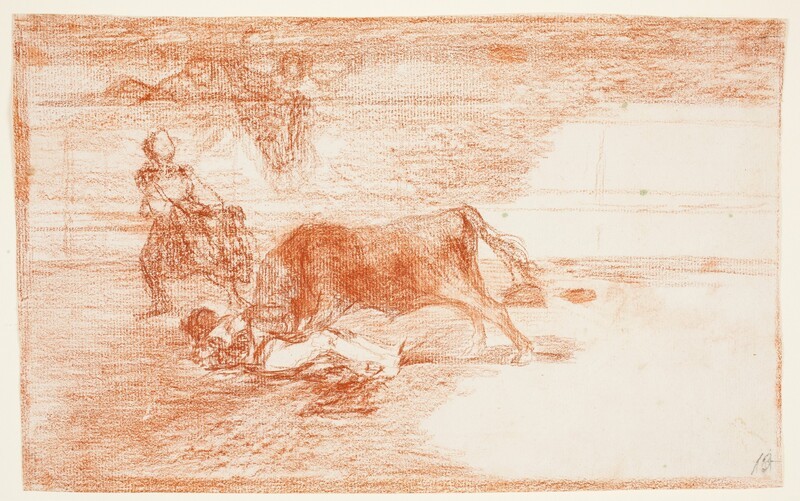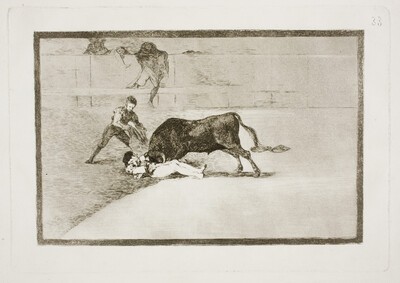- Cronología
- Ca. 1814 - 1816
- Ubicación
- The Prado National Museum. Madrid, Madrid, Spain
- Dimensiones
- 176 x 284 mm
- Técnica y soporte
- Reconocimiento de la autoría de Goya
- Documented work
- Titular
- El Prado National Museum
- Ficha: realización/revisión
- 03 Oct 2021 / 22 Jun 2023
- Inventario
- (D4318)
- Otros títulos:
-
13 (in pencil, bottom right-hand corner)
See How the ancient Spaniards hunted bulls on horseback in the countryside.
This preparatory drawing passed by inheritance in 1828 to Javier Goya, the painter's son, and in 1854 to Mariano Goya y Goicoechea, the artist's grandson. It was subsequently owned by Valentín Carderera (ca. 1861) and Mariano Carderera (1880). In 1886 it was acquired from Mariano Carderera, along with many other drawings by Goya, including almost all the preparatory studies for the Bullfight, by the Directorate General of Public Instruction, and was assigned to the Prado Museum, where it entered on 12 November 1886.
See How the ancient Spaniards hunted bulls on horseback in the countryside.
Preparatory drawing for the print The unfortunate death of Pepe Illo in the Madrid square. This is a scene with only a few characters, the strictly necessary ones, which are the focus of the composition, which will remain almost unchanged when it is transferred to the plate and therefore to the print. We see in detail, although not as much as in the later engraving, how the bull mortally wounds the famous bullfighter Pepe Illo and how he tries to free himself from the pitón. At his side, a member of the bullfighter's team tries unsuccessfully to divert the bull's attention so that he releases the bullfighter, who dies in the bullring infirmary twenty minutes after the goring.
In the drawing we can see how Goya resolves almost all the figures with rapid strokes, although he places somewhat more emphasis on the bull than on the other elements. Nor does he neglect the lighting. In fact, we see how the shadows of the bullrings are projected onto the arena, which helps to convey the idea that we are in a circular space. We can intuit the barrier, which is only sketchily drawn, where it seems that two people are trying to jump into the bullring, as in the later engraving, where this action is, however, more developed and defined.
-
Los dibujos de GoyaMuseo Provincial de ZaragozaZaragoza1978exhibition organized by Museo Provincial de Zaragoza, Ministerio de Cultura and Ayuntamiento de Zaragoza, exhibition guide written by Miguel Beltrán Lloris and Micaela Pérez Sáenz. October 1978pp. 36-37, cat. 88
-
Goya (1746-1828). Peintures-Dessins-GravuresCentre Cultural du MaraisParís1979consultant editors Jacqueline et Maurice Guillardcat. 79
-
Madrid2002
-
Madrid2019cat. 139
-
1946pp. 177-216, espec. pp. 207-210
-
MadridMuseo del Prado1954cat. 184
-
ParísLe Club Français du Livre1963p. 142
-
Vie et ouvre de Francisco de GoyaParísOffice du livre1970p. 280, cat. 1218
-
Barcelona1974pp. 17-18
-
The Changing image: Prints by Francisco GoyaBostonMuseum of Fine Arts1974pp. 244-247
-
Dibujos de Goya, 2 volsBarcelonaNoguer1975pp. 402-403, cat. 276
-
El mundo de Goya en sus dibujosMadridUrbión1979pp. 207-208
-
MadridMuseo Nacional del Prado2001pp. 97-99
-
MadridMuseo Nacional del Prado2019pp. 220-221

